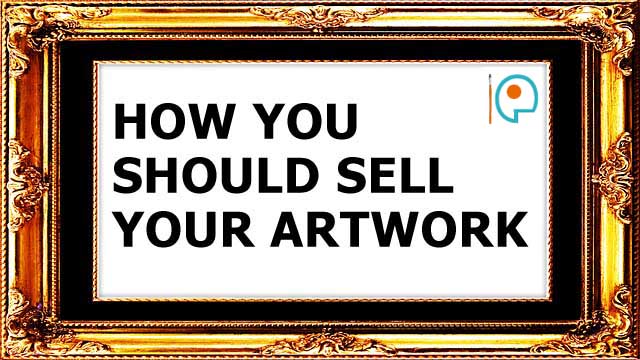Text version: How Should I Sell My Work? Framed? Matted?

This question always comes up with starting-out/emerging, mid-career and end-of-career artist. What is the best way to present my work to clients? Should you have your work framed or unframed, matted or framed for paper pieces?
There are a couple of options and each decision depends on the situations such as where are you selling your work, what your work is like and what you want to invest. Having framed thousands of works myself a lot of times it struck me how anyone can put such an ugly frame around such a gorgeous work of art. As every artist knows a good frame or a great matt can make or break a work of art.
 1. Cost - Cost - Cost
1. Cost - Cost - Cost
In my opinion this is the most important question when it comes to framing your work. Frames can be so expensive that they may add quite a lot to the price of your work and then it won't sell. Some have suggested to go hunt down used frames at flea markets, Salvation Army type stores or simply to make them yourself. All of those are good ideas and keep costs down, but they still add to the price of the work and if your work retails for let's say for around $500 - $1,000 and the frame costs $200 - $300 it's definitely NOT worth your effort to frame the work prior to selling it.
Think about some cheaper options or take a look at what other artists are doing. I would suggest to use a strip of wood that's let's say 1/4" thick and 1 3/4" wide or however thick your stretcher is. It's cheap and easy to use, you can paint it any color you want and it gives a finished look to the work. No more ugly staples or nails on the edges.
When you sell your work in the online world, framing is a definite aspect you need to consider and it falls under the category cost - cost - cost. If you are shipping overseas every ounce you add to the package will increase the cost of shipping. It used to be fairly cheap to ship a painting to Europe via Fedex or UPS but that has gone haywire and now is at a minimum of around $200 - $400 and unless you are selling in the $10k+ category clients are always concerned about additional shipping costs and additinal framing costs. Maybe I should do another quick blog on shipping artworks and what to look out for and what's best these days. You let me know if there is any interest. So, back to selling online and frames. It is definitely cheaper to ship unframed and will keep costs down tremendously. So, when you sell online you always need to include the information whether it's framed or unframed.
2. Client is always king or queen
Being straight forward with your client online or offline is the best way to handle the sale of a work framed or unframed. If the client visits your studio or art fair booth or any exhibition and the work is in a frame, then the frame is included, period. You cannot add additional cost to the price of the work later on if it's framed when it's displayed. Charging additional cost or telling the client "but the work doesn't come with the frame" will kill any deal you just had. So, if you don't want the frame to go then don't even display it framed and just put a nice strip of wood around the edges.
Honesty is always the best way to handle your clients. There is nothing wrong about asking the client if they like the frame and if they intend to keep the frame or have it reframed. If they say "I love the piece but the frame just doesn't fit with my walls" then you can ask if they would mind if you could keep the frame for another work. I know it's a clichee - but, "it doesn't fit with my couch". Yes, it's annoying to see your work leave your inner sanctum just to be paired with a pink couch, but it's a sale - so buck it up, take a deep breath and keep going!
3. Client framing gives the client better options
I have sold thousands of works of art during my time and I usually suggest that the client has the work framed to their own taste. It involves the client in the "creative" process and makes them feel better about their decisito purchase the work. They can complete the final steps, make the work ever more precious to them and feel complete. They will come back if they did a good job and it fits exactly how they wanted it. The client can choose how much to spend on the frame and whether they want to use and antique frame or a modern frame. They can streamline it with their own environment and you don't have to do it for them - how great is that? If you are selling in a familiar location you should always give the client a sheet of reputable framers or reinsure them that there are many reputable framers or frame shops around. You need to make sure that the shops you suggest are good, reliable and have insurance.
So, when I was schlepping artworks for my first gallery job in Berlin, Germany in the early 1980's - the gallery owner told me one day to just take the one Picasso painting and I think it was a Magritte painting and throw them in the back of the Mercedes wagon and drive them across town to the framer. I was aghast at him not even packing up the valuable paintings (over $4 mill. at that time) but for me to just carry them across Berlin's Kurfuerstendam during lunch time unprotected -- to my big relief we arrived safely at the framer and he did a great job. They looked much better reframed later on although tastes and values have changed and lean more towards original frames these days.
I had also taken a Max Ernst collage on that road trip across town and unfortunately, it did not fair so well. We got a call at the gallery next day that the framer's cat had shredded the gorgeous collage ($23k), but that he had insurance and that all would be fine. I don't remember what happened with it in the end, but that's why I mentioned the importance of a reputable framer or frame shop! If you are an artist that does framing on the side to support the studio rent, make sure you have insurance. It only takes one crazy kitty or one jar of thinner and one valuable piece to get you into trouble.
If you are selling online this is obviously not your concern other than to suggest that shipping unframed will lower shipping costs. Don't forget a lot of paintings get shipped rolled in a tube as well because once it becomes oversize it's almost unafordable to ship anywhere but to your mom a couple of houses over.
 4. The completed product
4. The completed product
Yes, some will tell you that you want the work framed ready to hang, voila - no effort on your client's end and it's on the wall above the lovely pink couch within minutes. Nothing to do other than just say "Oh doesn't that fit so well? I love the piece. It looks so great with the couch..." Ok, I get it! In some situation it's definitely advantageous to have the product as ready and completed as possible. Some clients want ready to go artwork. Especially with paper pieces and lower priced paintings - these works need to be sold in ready to go condition. They should be at least matted but also often framed. For a paper piece clients expect them to be matted and framed and ready to go.
You add a regular, "generic matte" and non expensive frame to the work and you have a product ready to go. It makes you look professional as an artist. If you send the work to the frame shop the cost will increase too much because you have to invest into their labor cost, cost of matte and markup of framing material. It gets really expensive in no time especially if you are buying 20 frames at a time and you don't know when they will sell. So, best to do paper pieces yourself or buying ready to go frames at your local box store or cheap online. Whatever option you choose, you need to make sure that they look professional and fit your work. You have the eye and will choose the best possible option, I am sure!
Back to the online world again. If you are shipping a framed paper piece you need to make sure that you use plexiglass instead of real glass. You don't want the work to arrive with broken glass shredding your latest watercolor and having to haggle with the shipping company; they always seem to want to wiggle their way out of paying and putting the blame on you. If you are shipping a paper piece it's best to have it matted or rolled in a tube for overseas, but that's an entirely different discussion. It does lower the cost of shipping to ship unframed and if you do a lot of that you will get the hang of what works best for you in no time.

So, it really comes down to where you sell and what you sell. The main point for all of this is whatever option you choose the work needs to look professional and not unfinished. Do you want to invest a lot of money in framing material? I would not unless you have a guaranteed sales pipeline and the works are flying off the shelf. I personally would go out get myself a cheap handsaw (make sure to get one with a fine blade), some sandpaper and lots of strips of wood. If you have a table saw in your studio and build your own stretchers even better, rip down some boards, sand 'em and paint 'em and you got a frame ready to go. If you want to go fancier get your router out and make your own frames. Is it worth the time to go to the Goodwill store and hunt for frames? Then you have to cut them and re-glue them and it bet takes more time away from your studio than the other options. Furthermore, if all your framing is the same it will be easier to compile a body of work for exhibition, ready to go. It will also make your product in the studio look more professional instead of having a 30 different framed pieces lying around, it will look like the old Camden Market in London and not like a professional artist studio.
If you are working with paper pieces, you need to learn to cut your own mattes. It's not especially hard and a lot cheaper than having to go to a frame shop for every matte. A matte cutter costs anywhere from $20 to $300 and if you are really strapped you can make your own with a razor blade that you use for scraping paint off windows and a little practice (start with free cardboard material instead of real mattes to learn it). The other option is to find mattes already cut to a certain size wholesale and buy a pack of 20+. But, that will restrain you to a certain size of paper you can work with. But, as you can see options are open ended - you will choose the best one for you at this point in time!
I am sure everyone would love it if you shared some ideas and personal experiences in the comment section below.
About Markus Kruse - BFA, MA, PhD
Markus, founder & owner of absolutearts.com started his art career at a gallery in the early 1980's in Berlin, Germany. Since then he has actively participated in the art world: worked with thousands of contemporary artists all over the world; curated exhibitions for years; directed several art galleries; organized many artshows; sold thousands of artworks; taught college for a while and has applied his in depth knowledge and expertise to further the online art world. He has always shared his expertise and helped artists further their artistic careers. Interested in getting ahead - take advantage of our private consulting sessions?




